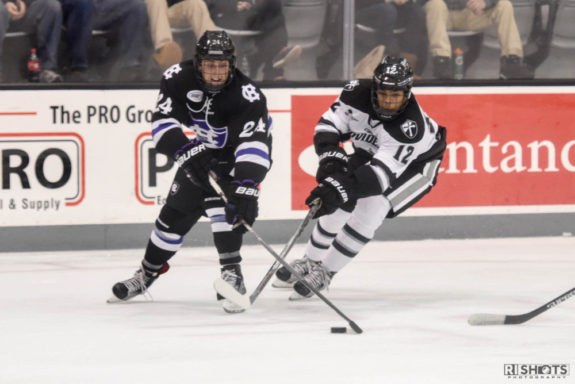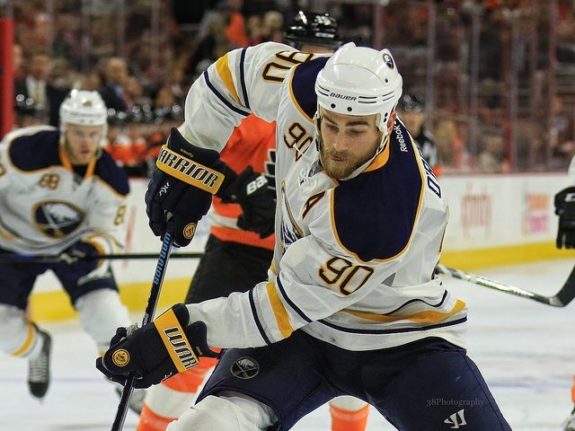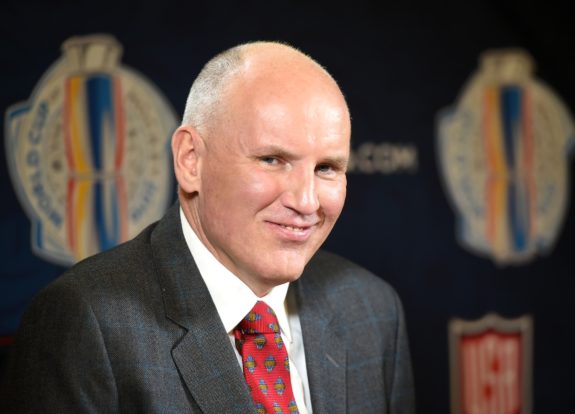In what has already been a momentous offseason for the St. Louis Blues, the biggest single move without question was the trade that sent five assets to the Buffalo Sabres in exchange for veteran center Ryan O’Reilly. In recent years, Blues general manager Doug Armstrong has been extremely active on the trade market, reshaping a team that has disappointed since it peaked in a Western Conference Final berth in 2015. But the question remains: has Armstrong improved the Blues? Let’s take a look at the moves.
Shattenkirk Says So Long
The first move we’ll consider is the 2017 trade that sent Kevin Shattenkirk to the Washington Capitals in exchange for Zach Sanford and a first-round pick in the 2017 NHL Draft (goaltending prospect Pheonix Copley also returned to Washington in the deal). Shattenkirk was beloved in his time with the Blues, spending parts of seven seasons in St. Louis after being acquired in the trade that sent former first overall pick Erik Johnson to Colorado. In that time, Shattenkirk recorded 258 points in 425 games, and was the Blues’ most prolific offensive defenseman.

“Shatty,” as he was known by fans and teammates alike, was a valuable piece to the Blues, but he was approaching UFA status, and the Blues did not expect to be able to keep him alongside fellow defenseman and team captain Alex Pietrangelo (Shattenkirk ultimately signed with the Rangers, his childhood team, for four years at an AAV of $6.65 million). The Blues were not a strong playoff competitor, and so they parted ways with Shattenkirk. At the time, the haul the Blues received was questioned, but a first-round pick is valuable capital in the league, capital which Armstrong would maximize in a future deal.
An Eventful Draft Day
Despite selling Shattenkirk, the Blues still made the playoffs in 2017 and even advanced to the second round. As a result, they entered draft day with two first-round selections – the 20th overall pick (their own) and the 27th overall pick (which they acquired from Washington). With the first pick, they drafted Robert Thomas, now their top prospect. But when the second pick was to be announced, it was NHL Commissioner Gary Bettman, not Blues’ Scouting Director Bill Armstrong, on the stage. Bettman announced a trade: the Blues had traded their second pick, originally the Capitals’ selection, along with their first-round pick in the next season, and Jori Lehtera, to the Philadelphia Flyers for Brayden Schenn.

But the Blues were not done for the day. Before the final pick of the first round, the 31st pick, Bettman stepped to the podium again. The Stanley Cup Champion Pittsburgh Penguins, owners of the 31st pick, had traded it to the St. Louis Blues, along with Oskar Sundqvist, in exchange for Ryan Reaves and a second-round pick (51st overall). With the pick, the Blues selected Klim Kostin, now one of their other most highly regarded prospects. For the day, the Blues had still made two selections, while adding Schenn and Sundqvist, and losing Ryan Reaves and a second-round pick. Schenn, a former fifth overall selection himself, went on to have a career year with the Blues, recording 70 points, centering what was, at times, one of the hottest lines in the NHL, between Jaden Schwartz and Vladimir Tarasenko.
Another Deadline Sale
Despite how hot that line was, the Blues found themselves again underachieving at the deadline, and again with a pending UFA to sell. This time, it was native St. Louisan Paul Stastny, who had spent the past four seasons in Blue, who was shipped off. The Blues made something of a surprise trade on deadline day, dealing Stastny in their own division to the Winnipeg Jets. The Jets and GM Kevin Cheveldayoff would send a first round pick back to the Blues (giving them back a pick in the 2018 first round) along with college prospect Erik Foley.

Stastny found immediate chemistry with the young and explosive forward group in Winnipeg, while the Blues continued to falter and ultimately missed the playoffs, for the first time in six years, by one single point. The Jets made it all the way to the Conference Final, meaning the pick the Blues received would be 29th overall. The Blues would not settle there, though, as Armstrong made yet another trade, trading up to pick 25 with the Toronto Maple Leafs, surrendering a third-round pick along with the 29th overall. At 25, the Blues selected German winger Dominik Bokk, who they went on to sign to an entry-level contract.
A Summer Blockbuster
Trading up in the draft would hardly be Armstrong’s biggest move of the summer. After days and weeks of rumors, the Blues finished free agent signing day with a bang, completing a four-player, two-pick trade with the Buffalo Sabres to acquire Ryan O’Reilly. On the surface, the Blues surrendered a lot, sending Buffalo a 2019 first-round pick, a 2021 second-round pick, Tage Thompson (their first-round pick in 2016), and two roster players – Vladimir Sobotka and Patrick Berglund – all in exchange for O’Reilly. But considering several factors (that the first round pick was top ten protected, that the Blues surrendered Thompson, and not one of their more prized prospects, and that Sobotka and Berglund were moved to even out salary) the trade ultimately looked pretty even.

The O’Reilly trade would be the centerpiece of a summer overhaul for the Blues, one that would see five new faces on the team (O’Reilly, David Perron, not exactly a new face, Tyler Bozak, Chad Johnson, and, recently, hometown kid Pat Maroon) and multiple faces leaving as well (Sobotka, Berglund, and goaltender Carter Hutton among them). It remains to be seen how any of these players will do in a Blues uniform, but in the past year and a half, Doug Armstrong has certainly overhauled his team.
The Final Tally
Starting with the Shattenkirk trade, the Blues have made five trades, not counting pick-for-pick trades. Let’s take a look at all the pieces that have moved in those deals:
Out: Kevin Shattenkirk, Pheonix Copley, Jori Lehtera, Ryan Reaves, Paul Stastny, Vladimir Sobotka, Patrik Berglund, Tage Thompson, a 2017 first round pick (27th overall) a 2018 first round pick (14th overall), a 2019 first round pick (top ten protected), a 2017 second round pick (51st overall), a 2021 second round pick
In: Zach Sanford, Brayden Schenn, Oskar Sundqvist, Erik Foley, Ryan O’Reilly, a 2017 first round pick (27th overall, traded) a 2017 first round pick (31st overall, Klim Kostin), a 2018 first round pick (traded up, 25th overall, Dominik Bokk)
Ultimately, the Blues have recaptured each of the first round picks they’ve surrendered in trades, save the two surrendered in the O’Reilly trade. In the process, they have totally overhauled their roster, removing three of their worst contracts (Lehtera, Reaves, and Sobotka), selling their departing UFAs for future assets, and adding two top six forwards to their group for the coming years.
Strong-Arming the Trade Market
Only time will tell whether the moves Armstrong has made are the right ones. But at present, it certainly appears that Armstrong has built the team a stronger group of prospects than they have had in recent memory (at least since the year they drafted both Schwartz and Tarasenko) and simultaneously has created as strong a roster or stronger than the one that took them to the conference finals.

If the Blues are to win their first ever Stanley Cup, say, within the next decade, it is highly probable that fans will look back upon this series of moves as the start of the team’s momentum towards that achievement. There had been questions about whether the extension the team gave Doug Armstrong this past winter was valid, or whether perhaps it was better for St. Louis to move on. I think if you asked most fans the same question today, their answer would be very much in the affirmative.